Make a homemade Shoyu Ramen from scratch with this easy and delicious recipe! Recipe with step-by-step photos.

Ramen Noodle Soup
When I think of ramen, I think of the many cheap and cheerful meals my friends and I used to eat at the food courts in Brisbane during our years as university students or new graduates. Back then, even though money was tight, we somehow ate out a lot, and the Japanese and Korean stalls were high on our list of favourite places to eat.
I recall fondly the made-to-order ramen noodle soups, served in small disposable plastic bowls with the hard-to-use plastic cutlery. It was typically the cheapest item on the menu, but I always felt it was the most nourishing.
Ramen in Paris
One of the first things I noticed upon moving to Switzerland was the absence of food courts on this side of the world. Japanese restaurants were just as rare back then, so I often sought out Japanese cuisine whenever we travelled abroad. And one of my favourite destinations for Japanese food is Paris.
I have never been to Japan (unless you count an unscheduled overnight stay at Narita Airport), but I am convinced that Paris has the best Japanese food outside of Japan.
For me, no trip to Paris is complete without a stop on rue Sainte-Anne for a bowl of ramen from one of the many Japanese restaurants which line this street.
Paris completely changed my ramen experience; my once budget-friendly lunch became a culinary event which was a bit more exciting each and every time.

Shoyu Ramen
If you visit any Japanese restaurant, you will see that there are different types of ramen soups.
Shoyu Ramen is typically made from a chicken broth, but it is frequently served with pork, namely thinly sliced pieces of Chashu Pork. This is pork belly which has been slow-cooked in an aromatic liquid, and then thinly sliced before serving.
The accompaniments vary from restaurant to restaurant and, like many noodle soups, you can generally customise your bowl to your liking.

Shoyu Ramen Recipe
Shoyu Ramen is made from a flavourful chicken broth which is seasoned with shoyu, which is the Japanese term for soy sauce, hence the clear and golden-coloured broth.
To make a ramen broth which has been infused with all of the necessary aromatics, I highly recommend setting aside a rainy weekend to make the ramen broth from scratch. The broth might take a long time to prepare, but the recipe itself is very easy.
My recipe for Shoyu Ramen starts with roasting the chicken wings first to make them golden and crispy, which is required to give the ramen broth that beautiful golden colour. Roasting the chicken wings also gives the broth an extra boost of umami and bold flavours which you would not get if you simply used raw chicken wings.
Roasting the chicken wings might add an extra hour to your cooking time in making the ramen broth, but I promise that this step is totally worth it. Treat yourself to a few of the crispy chicken wings before you go about making the broth 😉
How to Make Shoyu Ramen
Step 1
If the chicken wings are relatively large (which they tend to be outside of Europe), I recommend separating the wings by using a sharp knife to cut them at the joints.
Lightly oil two large sheet pans. Place the chicken wings on the pans and use a pair of tongs to coat the wings in the oil.
Season the chicken wings lightly with salt, and then roast for about 1 hour, or until the chicken wings are golden and crispy.
For this step, I recommend using the oven with the fan settings which will help to crisp up the chicken wings.

Step 2
Remove the roasted chicken wings to a large stock pot. (Treat yourself to a few chicken wings – cook’s treat!)
Place the sheet pans on the stove over medium-high heat. Pour some boiling water into each pan, enough to just cover the caramelised bits and pieces on the pans (the fond).
Simmer gently for a few minutes, and use a whisk (I like to use a flat whisk) to lift the caramelised pieces from the bottom of the pan.
You should have a golden-coloured liquid. Pour the golden liquid into the stock pot.
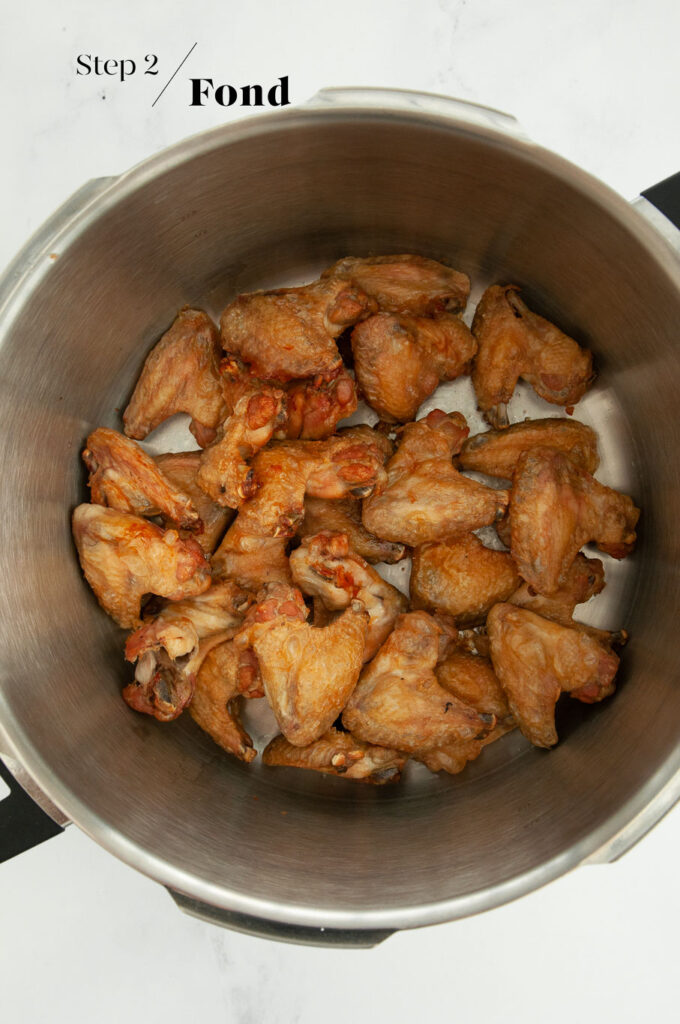
Step 3
Place the stock pot on the stove over medium-high heat.
Add enough boiling water to cover the chicken wings by about 5 cm/2 inches. It is important to not use too much water at this point, as it may produce a weak and diluted broth. It is better to make a concentrated broth which you can dilute later with more water.
Add the spring onions, garlic, ginger, shitake mushrooms and kombu.
Simmer gently for 3 hours. During this time, skim the surface of the broth to remove any impurities. Also, maintain the water level by adding more boiling water as necessary.
After 3 hours, use a slotted spoon to remove the chicken wings and aromatics to a large bowl. You can discard these items, or reserve the meat from the chicken wings to serve with the soup or another meal. Generally, I find that, after 3 hours, all of the flavour has been extracted from the meat into the broth. But the meat is definitely still edible. I generally reserve the shitake mushrooms which would, by now, be very soft and flavourful.
Strain the broth through a fine sieve into another large, clean stock pot. To remove the excess fat in the broth, place a sheet of kitchen paper on the surface of the broth and quickly remove it. Repeat this step a few times until most of the fat has been removed – you still want to leave some fat in the soup for flavour, but not so much that it makes the dish taste greasy.
Place this pot on the stove over medium-high heat. Bring to a gentle simmer, and add the sugar, salt, soy sauce and mirin. Taste for seasoning.
When tasting for seasoning, you might want to add more salt or soy sauce. Keep in mind that soy sauce would further darken the broth. If the broth tastes too concentrated, add some more boiling water.
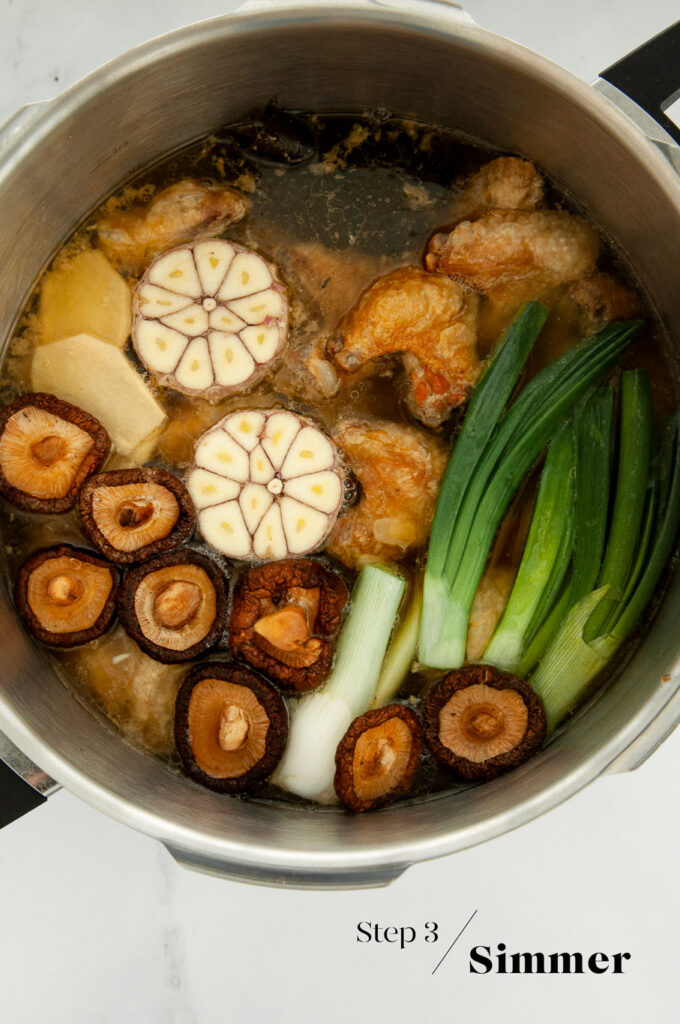
What to Serve with Shoyu Ramen
When it comes to noodle soups, I tend to adopt the “less is more” approach. This is because my favourite part of the dish is simply just eating the noodles and slurping the soup. The accompaniments are there to make the dish more substantial and interesting, but my preference is to keep things simple.
But the best thing about noodle soups is that you can always customise the bowl to your liking.
In my family, my son is not the biggest fan of noodles (unless it is Pho), so I go heavy on the vegetables for him. My daughter, on the other hand, is more like me, so she gets a big serve of noodles with slightly less meat and veges. I am not a big meat eater so I will often skip the meat but I might add some silken tofu instead.
When it comes to vegetables, I often use what I have to hand, which may not be typically found in a ramen soup. For example, if we have leftover snow peas, cauliflower or courgettes (zucchini) in the fridge, I will add them to almost any noodle soup dish.
For a ramen soup, common accompaniments include:
- Soft-boiled eggs. You can use regular soft-boiled eggs or soy sauce eggs.
- Green vegetables such as bok choy or broccolini. My favourite Japanese restaurant in Paris serves their Shoyu Ramen with baby rocket leaves.
- Yellow corn. I recommend cooking some corn on the cob, and then slicing off large sections of kernels.
- Fermented bamboo shoots, or menma. These add texture and a slight tanginess to the soup.
- Toasted nori or seaweed sheets.
- Lightly blanched bean sprouts.
- Thin slices of Chashu Pork. This is pork belly which has been slow-cooked in an aromatic broth, thinly sliced and then pan-fried until caramelised. The pork is incredibly tender and should melt in your mouth. I always serve extra slices of Chashu Pork on the side because my family love it so much.
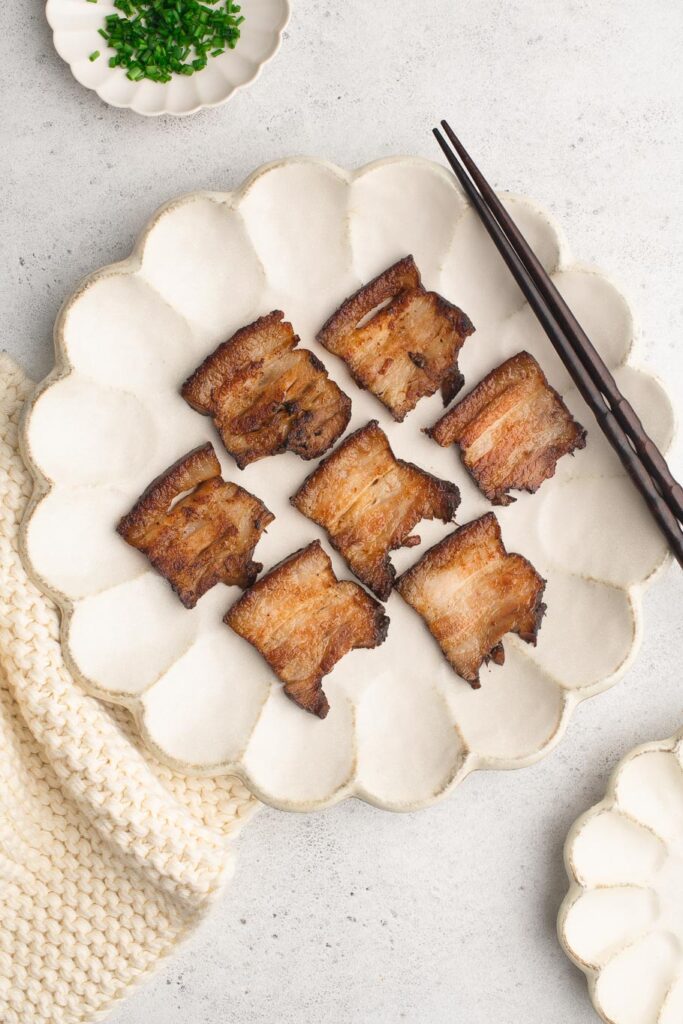
What Type of Ramen Noodles to Use
Most Asian grocers will stock Japanese ramen noodles, whether fresh, frozen or dried.
Dried curly ramen noodles are commonly found in most places, but my preference are the straight ramen noodles.
At a pinch, you can buy packets of instant ramen noodles, but discard the seasoning sachets inside.
Once in a while, I will come across freshly-made ramen noodles at my local Japanese grocer, and I have also attempted to make my own Homemade Ramen Noodles (I will share the recipe very soon).
Fresh Chinese-style egg noodles (the thin variety) also work well with a ramen broth.
Freshly-made noodles always taste more superior to their dried counterparts, so if you can get your hands on them, I highly recommend them.
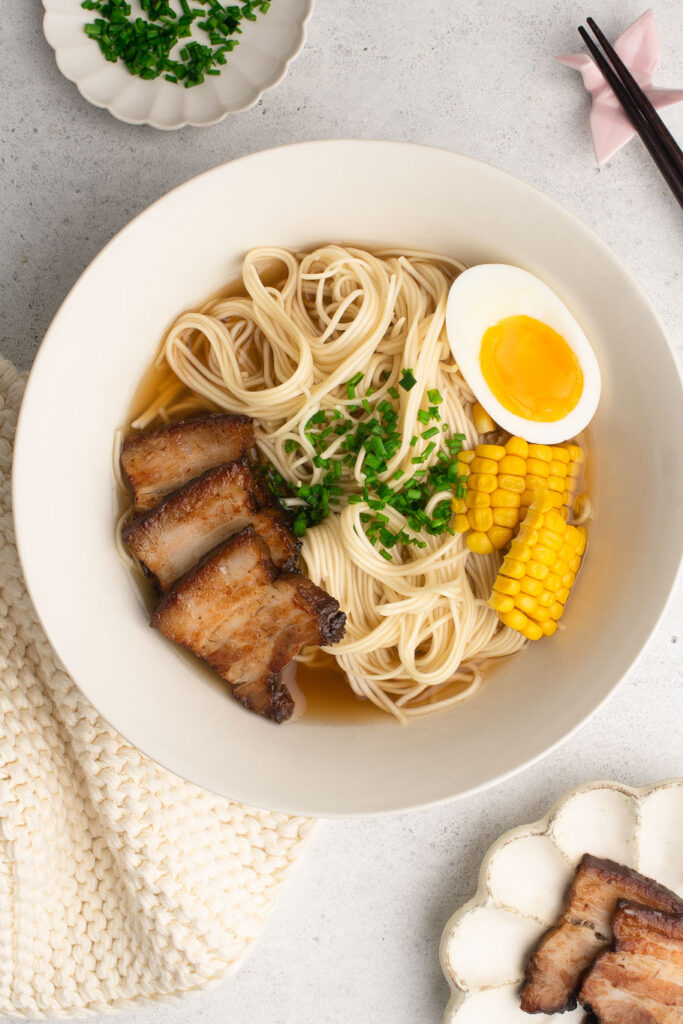
Tips for Making Shoyu Ramen
- For the full ramen experience, start by making the Chashu Pork the day before. This needs to cool overnight in the braising liquid, so it is best to make this at least 1-2 days in advance. Chashu Pork also freezes well.
- You will need at least 4 hours to make the ramen broth from start to finish. However, during this time, little effort is required on your part while the broth is simmering away on the stove.
- Due to the time that it takes to make the ramen broth, I recommend making a large quantity as per the recipe, and to freeze any leftover ramen broth. I recommend freezing the broth in portions for 1 or 2 servings (approximately 300 ml per serving).
- While the broth is simmering, prepare all of the accompaniments. This includes making the soft-boiled eggs, steaming or par-boiling any green vegetables, cooking the noodles.
- To serve, I like my noodle soups to be piping hot. So I generally prepare each bowl separately by bringing enough broth to the boil in a medium-sized saucepan. Add any vegetables or accompaniments which you like to serve hot, then add the noodles right at the end. Immediately pour everything into a large noodle bowl and serve immediately. The resulting dish won’t look carefully constructed and Instagram-pretty, but all of the components will be at the perfect temperature.
Shoyu Ramen
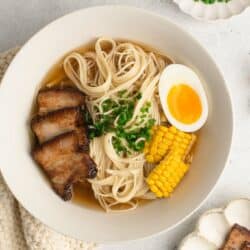
- Prep Time: 15 minutes
- Cook Time: 4 hours
- Total Time: 4 hours 15 minutes
- Yield: Serves 8 to 10
- Category: Dinner
- Method: Stove
- Cuisine: Japanese
Make a homemade Shoyu Ramen from scratch with this easy and delicious recipe! Recipe with step-by-step photos.
Ingredients
For the Ramen Broth
- 2 kg (4.5 lb) chicken wings
- 2–3 tablespoons vegetable oil
- fine salt
- 5–6 spring onions (scallions)
- 1 head of garlic, halved horizontally
- 5 cm (2 inch) piece of ginger, thickly sliced
- 8 dried shitake mushrooms
- 1 sheet (20 cm/8 inch) kombu (Japanese seaweed)
- 1 tablespoon sugar
- 1–2 teaspoons sea salt
- 60 ml (1/4 cup) soy sauce
- 2 tablespoons mirin
To Serve
- fresh or dried ramen noodles, cooked according to packet instructions
- soft-boiled eggs, halved
- chashu pork, sliced and pan-fried
- corn on the cob, boiled and sliced in large sections
- bok choy, broccolini or other greens, steamed or par-boiled
- chives or spring onions (scallions), sliced
- toasted sesame oil, to drizzle
- shichimi togarashi, optional
- chilli oil, optional
Instructions
To Roast the Chicken Wings
- Preheat the oven to 200°C/390°F (with fan to help crisp up the chicken wings).
- Place the chicken wings onto two large sheet pans which are also suitable to use on the stove (i.e. heavy-based stainless steel).
- Drizzle with some oil and give the wings a good mix so they are all well coated.
- Lightly season the chicken wings with some salt.
- Roast the chicken wings for about 1 hour, or until they are golden and crispy.
- Remove the chicken wings to a large stock pot.
- Place the sheet pans on the stove over medium-high heat.
- Add just enough boiling water to cover the caramelised bits and pieces on the sheet pan (the fond).
- Let the water simmer away gently for a few minutes.
- Use a whisk to lift the caramelised pieces from the bottom of the pan and dissolve it in the water.
- You should now have a golden-coloured liquid in the pan.
- Carefully pour the golden liquid into the stock pot with the roasted chicken wings.
To Make the Ramen Broth
- Place the stock pot on the stove over medium-high heat.
- Pour in enough boiling water to cover the chicken wings by about 5 cm/2 inches. If you add too much water, it may make the broth too diluted. So it is better to make a concentrated broth which you can adjust with more water later, if necessary.
- Add the spring onions, garlic, ginger, shitake mushrooms, and kombu.
- When the pot nearly comes to a boil, turn the stove down to low heat.
- Simmer the broth gently for 3 hours.
- During this time, skim the broth regularly to remove any impurities. Also, maintain the water level by adding more boiling water as necessary.
- After 3 hours, use a slotted spoon to remove all of the chicken wings and aromatics to a large bowl. You can discard these items or reserve the meat from the chicken wings to eat with the broth or another dish.
- Strain the broth through a fine sieve into another large, clean stock pot.
- To remove the excess fat from the broth, place a sheet of kitchen paper on the surface of the broth and quickly remove and discard it. Repeat this step a few more times. You want to leave a bit of fat in the broth for flavour.
- Place the pot with the strained broth on the stove over medium-high heat.
- Add the sugar, salt, soy sauce and mirin.
- Taste for seasoning. You may need to add more salt or soy sauce, and/or more boiling water if the broth is too concentrated.
To Serve
- Place the noodles into large soup bowls.
- Ladle over the hot broth.
- Add your desired accompaniments.
- Serve immediately.
Kitchen Notes
 FREEZING RAMEN BROTH
FREEZING RAMEN BROTH
Ramen broth freezes very well. I recommend freezing the broth in portions for 1 to 2 (approx. 300 ml/1 cup plus 3 tablespoons per portion).
 OVEN & STOVE TEMPERATURES
OVEN & STOVE TEMPERATURES
All recipes on this website have been tested on an induction stove and/or with a conventional oven (i.e. an oven without fan). All recipes on this website state temperatures for a conventional oven, unless otherwise mentioned. If you have a convection oven (i.e. an oven with a fan), please consult the manufacturer’s handbook on how to adjust the temperature and baking time accordingly.
 Print
Print Pin Recipe
Pin Recipe Rate
Rate
This recipe was amazing! I’ve always been intimidated by Japanese recipes but you made this one seem so easy. The broth was absolutely delicious.
This was probably the best ramen soup I have ever tasted! A labor of love but so worth it. My only suggestion is to perhaps use more kombu and dried shitake mushrooms for a more intense flavor but that is just my preference. Otherwise this recipe is definitely a keeper.
Really delicious recipe. I’ve made ramen stock a few times using chicken bones but I agree that there is more flavor from roasting the chicken first. Although I’m tempted to say that the difference is not huge, snacking on a few crispy chicken wings was absolutely a highlight!
Oh my goodness, this Shoyu Ramen recipe from Eat Little Bird looks absolutely incredible! The careful preparation and artful presentation of this dish are simply stunning. I can already imagine the aroma of the rich soy-based broth and the tender slices of marinated pork. The perfectly cooked noodles nestled among the vibrant green vegetables create a feast for the eyes. It’s evident that a lot of thought and skill went into creating this bowl of pure comfort and satisfaction. I’m eager to try this recipe and experience the umami flavors that are sure to dance on my taste buds. Hats off to Eat Little Bird for sharing such a visually enticing and mouthwatering recipe!
Thank you, Madalaine! This recipe is a labour of love, but so worth it 🙂